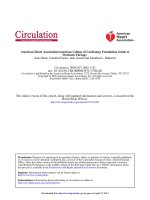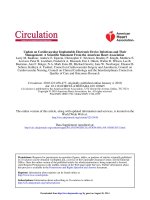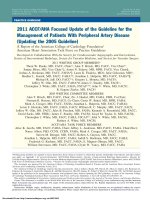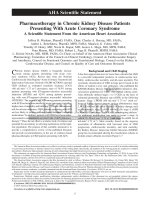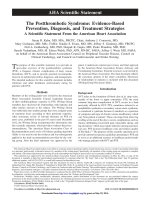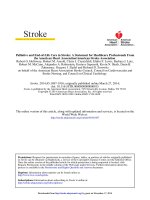AHA thoracic aortic adisease 2010 khotailieu y hoc
Bạn đang xem bản rút gọn của tài liệu. Xem và tải ngay bản đầy đủ của tài liệu tại đây (4.58 MB, 69 trang )
Learn and Live
SM
ACC/AHA Pocket Guideline
Based on the 2010 ACCF/AHA/AATS/
ACR/ASA/SCA/SCAI/SIR/STS/SVM
Guidelines for
the Diagnosis
and Management
of Patients With
Thoracic Aortic
Disease
March 2010
Downloaded From: on 01/27/2013
Downloaded From: on 01/27/2013
10. Recommendation for Intramural Hematoma Without Intimal
Defect. . . . . . . . . . . . . . . . . . . . . . . . . . . . . . . . . . . . . . . . . . . . . . . . . . . . . . 42
11. Recommendation for History and Physical Examination for
Thoracic Aortic Disease. . . . . . . . . . . . . . . . . . . . . . . . . . . . . . . . . . . . . . . 43
12. Recommendation for Medical Treatment of Patients With
Thoracic Aortic Diseases. . . . . . . . . . . . . . . . . . . . . . . . . . . . . . . . . . . . . . 44
12.1. Recommendations for Blood Pressure Control. . . . . . . . . . . . 44
13. Recommendations for Asymptomatic Patients With Ascending
Aortic Aneurysm. . . . . . . . . . . . . . . . . . . . . . . . . . . . . . . . . . . . . . . . . . . . . 46
14. Recommendation for Symptomatic Patients With Thoracic
Aortic Aneurysm. . . . . . . . . . . . . . . . . . . . . . . . . . . . . . . . . . . . . . . . . . . . . 50
15. Recommendations for Open Surgery for Ascending Aortic
Aneurysm. . . . . . . . . . . . . . . . . . . . . . . . . . . . . . . . . . . . . . . . . . . . . . . . . . . 51
16. Recommendations for Aortic Arch Aneurysms. . . . . . . . . . . . . . . . . . 52
17. Recommendations for Descending Thoracic Aorta and
Thoracoabdominal Aortic Aneurysms. . . . . . . . . . . . . . . . . . . . . . . . . . 54
18. Recommendations for Counseling and Management of
Chronic Aortic Diseases in Pregnancy. . . . . . . . . . . . . . . . . . . . . . . . . . 56
19. Recommendations for Aortic Arch and Thoracic Aortic
Atheroma and Atheroembolic Disease. . . . . . . . . . . . . . . . . . . . . . . . . 58
3
Downloaded From: on 01/27/2013
© 2010 American College of Cardiology Foundation and
American Heart Association, Inc.
The following material was adapted from the 2010 ACCF/AHA/
AATS/ACR/ASA/SCA/SCAI/SIR/STS/SVM Guidelines for the
Diagnosis and Management of Patients With Thoracic Aortic
Disease: Executive Summary (J Am Coll Cardiol 2010;55:1509–
44). This pocket guideline is available on the World Wide Web
sites of the American College of Cardiology (www.acc.org) and
the American Heart Association (my.americanheart.org).
For copies of this document, please contact Elsevier Inc. Reprint
Department, e-mail: ; phone: 212-633-3813;
fax: 212-633-3820.
Permissions: Multiple copies, modification, alteration,
enhancement, and/or distribution of this document are not
permitted without the express permission of the American
College of Cardiology Foundation. Please contact Elsevier’s
permission department at
Downloaded From: on 01/27/2013
3. Patients with Loeys-Dietz syndrome or a
confirmed genetic mutation known to predispose to
aortic aneurysms and aortic dissections (TGFBR1,
TGFBR2, FBN1, ACTA2, or MYH11) should undergo
complete aortic imaging at initial diagnosis and 6
months thereafter to establish if enlargement is
occurring. (LOE: C)
4. Patients with Loeys-Dietz syndrome should have
yearly magnetic resonance imaging from the
cerebrovascular circulation to the pelvis. (LOE: B)
5. Patients with Turner syndrome should undergo
imaging of the heart and aorta for evidence of
bicuspid aortic valve, coarctation of the aorta, or
dilatation of the ascending thoracic aorta. If initial
imaging is normal and there are no risk factors for
aortic dissection, repeat imaging should be performed
every 5 to 10 years or if otherwise clinically indicated.
If abnormalities exist, annual imaging or follow-up
imaging should be done. (LOE: C)
19
Downloaded From: on 01/27/2013
5. Recommendations for Familial Thoracic
Aortic Aneurysms and Dissections
Class I
1. Aortic imaging is recommended for first-degree
relatives of patients with thoracic aortic aneurysm
and/or dissection to identify those with asymptomatic disease. (LOE: B)
2. If the mutant gene (FBN1, TGFBR1, TGFBR2,
COL3A1, ACTA2, MYH11) associated with aortic
aneurysm and/or dissection is identified in a patient,
first-degree relatives should undergo counseling and
testing. Then, only the relatives with the genetic
mutation should undergo aortic imaging. (LOE: C)
Class IIa
1. If one or more first-degree relatives of a patient
with known thoracic aortic aneurysm and/or dissection are found to have thoracic aortic dilatation, aneurysm, or dissection, then imaging of second-degree relatives is reasonable. (LOE: B)
24
Downloaded From: on 01/27/2013
10. Recommendation for Intramural Hematoma Without Intimal
Defect. . . . . . . . . . . . . . . . . . . . . . . . . . . . . . . . . . . . . . . . . . . . . . . . . . . . . . 42
11. Recommendation for History and Physical Examination for
Thoracic Aortic Disease. . . . . . . . . . . . . . . . . . . . . . . . . . . . . . . . . . . . . . . 43
12. Recommendation for Medical Treatment of Patients With
Thoracic Aortic Diseases. . . . . . . . . . . . . . . . . . . . . . . . . . . . . . . . . . . . . . 44
12.1. Recommendations for Blood Pressure Control. . . . . . . . . . . . 44
13. Recommendations for Asymptomatic Patients With Ascending
Aortic Aneurysm. . . . . . . . . . . . . . . . . . . . . . . . . . . . . . . . . . . . . . . . . . . . . 46
14. Recommendation for Symptomatic Patients With Thoracic
Aortic Aneurysm. . . . . . . . . . . . . . . . . . . . . . . . . . . . . . . . . . . . . . . . . . . . . 50
15. Recommendations for Open Surgery for Ascending Aortic
Aneurysm. . . . . . . . . . . . . . . . . . . . . . . . . . . . . . . . . . . . . . . . . . . . . . . . . . . 51
16. Recommendations for Aortic Arch Aneurysms. . . . . . . . . . . . . . . . . . 52
17. Recommendations for Descending Thoracic Aorta and
Thoracoabdominal Aortic Aneurysms. . . . . . . . . . . . . . . . . . . . . . . . . . 54
18. Recommendations for Counseling and Management of
Chronic Aortic Diseases in Pregnancy. . . . . . . . . . . . . . . . . . . . . . . . . . 56
19. Recommendations for Aortic Arch and Thoracic Aortic
Atheroma and Atheroembolic Disease. . . . . . . . . . . . . . . . . . . . . . . . . 58
3
Downloaded From: on 01/27/2013
4
Downloaded From: on 01/27/2013
20. Periprocedural and Perioperative Management.. . . . . . . . . . . . . . . . 59
20.1. Recommendations for Brain Protection During Ascending
Aortic and Transverse Aortic Arch Surgery. . . . . . . . . . . 59
20.2. Recommendations for Spinal Cord Protection During
Descending Aortic Open Surgical and Endovascular
Repairs. . . . . . . . . . . . . . . . . . . . . . . . . . . . . . . . . . 60
21. Recommendations for Surveillance of Thoracic Aortic
Disease or Previously Repaired Patients. . . . . . . . . . . . . . . . . . . . . . . 62
22. Recommendation for Employment and Lifestyle in
Patients With Thoracic Aortic Disease. . . . . . . . . . . . . . . . . . . . . . . . . . 64
5
Downloaded From: on 01/27/2013
1. Introduction
The term “thoracic aortic disease” encompasses a
broad range of degenerative, structural, acquired,
genetic-based, and traumatic disease states and presentations. According to the Centers for Disease
Control and Prevention death certificate data, diseases of the aorta and its branches account for 43
000 to 47 000 deaths annually in the United States.
The precise number of deaths attributable to thoracic aortic diseases is unclear. However, autopsy studies suggest that the presentation of thoracic aortic
disease is often death due to aortic dissection (AoD)
and rupture, and these deaths account for twice as
6
Downloaded From: on 01/27/2013
14. Recommendation for Symptomatic Patients With
Thoracic Aortic Aneurysm
Class I
1. Patients with symptoms suggestive of expansion
of a thoracic aneurysm should be evaluated for
prompt surgical intervention unless life expectancy
from comorbid conditions is limited or quality of life
is substantially impaired. (LOE: C)
50
Downloaded From: on 01/27/2013
Class III
1. Perioperative brain hyperthermia is not recommended in repairs of the ascending aortic and transverse aortic arch as it is probably injurious to the
brain. (LOE: B)
20.2. Recommendations for Spinal Cord Protection During
Descending Aortic Open Surgical and Endovascular Repairs
Class I
1. Cerebrospinal fluid drainage is recommended as a
spinal cord protective strategy in open and endovascular thoracic aortic repair for patients at high risk of
spinal cord ischemic injury. (LOE: B)
Class IIa
1. Spinal cord perfusion pressure optimization using
techniques, such as proximal aortic pressure maintenance and distal aortic perfusion, is reasonable as
an integral part of the surgical, anesthetic, and perfusion strategy in open and endovascular thoracic
aortic repair patients at high risk of spinal cord ischemic injury. Institutional experience is an important
factor in selecting these techniques. (LOE: B)
2. Moderate systemic hypothermia is reasonable for
protection of the spinal cord during open repairs of
the descending thoracic aorta. (LOE: B)
60
Downloaded From: on 01/27/2013
Class IIb
Benefit ≥ Risk
Additional studies with broad
objectives needed; additional
registry data would be helpful
Procedure/Treatment
may be considered
Recommendation’s
usefulness/efficacy less
well established
n
n Greater conflicting
evidence from multiple
randomized trials or
meta-analyses
n Recommendation’s
usefulness/efficacy less
well established
n Greater conflicting
evidence from single
randomized trial or
nonrandomized studies
n Recommendation’s
usefulness/efficacy less
well established
Class III
Risk ≥ Benefit
Procedure/Treatment should
not be performed/administered since it is not helpful and may be harmful
or registries about the usefulness/
efficacy in different
subpopulations, such as sex, age,
history of diabetes, history of
prior myocardial infarction, history
of heart failure, and prior aspirin
use. A recommendation with
Level of Evidence B or C does not
Recommendation that
procedure or treatment is
not useful/effective and
may be harmful
n
Sufficient evidence from
multiple randomized trials
or meta-analyses
n
n Recommendation that
procedure or treatment is
not useful/effective and
may be harmful
Limited evidence from
single randomized trial or
nonrandomized studies
n
n Recommendation that
procedure or treatment is
not useful/effective and
may be harmful
Only diverging expert
opinion, case studies, or
standard of care
n Only expert opinion, case
studies, or standard of care
may/might be considered
may/might be reasonable
usefulness/effectiveness is
unknown /unclear/uncertain
or not well established
is not recommended
is not indicated
should not
is not useful/effective/beneficial
may be harmful
n
* Data available from clinical trials
imply that the recommendation is
weak. Many important clinical
questions addressed in the
guidelines do not lend themselves
to clinical trials. Even though
randomized trials are not available,
there may be a very clear clinical
consensus that a particular test or
therapy is useful or effective.
† In 2003, the ACCF/AHA Task Force
on Practice Guidelines developed
a list of suggested phrases to use
when writing recommendations.
All guideline recommendations
have been written in full
sentences that express a
complete thought, such that a
recommendation, even if
separated and presented apart
from the rest of the document
(including headings above sets of
recommendations), would still
convey the full intent of the
recommendation. It is hoped that
this will increase readers’
comprehension of the guidelines
and will allow queries at the
individual recommendation level.
Downloaded From: on 01/27/2013
9
2. Critical Issues
As the writing committee developed this guideline, several critical issues emerged:
n Thoracic
aortic diseases are usually asymptomatic and
not easily detectable until an acute and often catastrophic
complication occurs. Imaging of the thoracic aorta with
computed tomographic imaging (CT), magnetic resonance
imaging (MR), or in some cases, echocardiographic
examination is the only method to detect thoracic aortic
diseases
n Radiologic
imaging technologies have improved in terms
of accuracy of detection of thoracic aortic disease.
However risks associated with repeated radiation
exposure, as well as contrast medium–related toxicity have
also been recognized. The writing committee therefore
formulated recommendations on a standard reporting
format (Section 3) as well as surveillance schedules
(Section 21).
n Imaging
for asymptomatic patients at high risk based on
history or associated disease is expensive and not always
covered by payers.
n For
many thoracic aortic diseases, results of treatment for
stable, often asymptomatic, but high-risk conditions are far
better than the results of treatment required for acute and
often catastrophic disease presentations. Thus, the
identification and treatment of patients at risk for acute and
10
Downloaded From: on 01/27/2013
catastrophic disease presentations (eg, thoracic AoD and
thoracic aneurysm rupture) prior to such an occurrence are
paramount to eliminating the high morbidity and mortality
associated with acute presentations.
n Patients
with acute AoD are subject to missed or delayed
detection of this catastrophic disease state. Many present
with atypical symptoms and findings, making diagnosis
even more difficult. Awareness of the varied and complex
nature of thoracic aortic disease presentations has been
lacking, especially for acute AoD. Risk factors and clinical
presentation clues are noted in Section 7. The
collaboration of multiple medical specialties for this
guideline will provide opportunities to raise the level of
awareness among all medical specialties.
n There
is rapidly accumulating evidence that genetic
alterations or mutations predispose some individuals to
aortic diseases (see Sections 4-6). Therefore, identification
of the genetic alterations leading to these aortic diseases
has the potential for early identification of individuals at
risk. In addition, biochemical abnormalities involved in the
progression of aortic disease are being identified through
studies of patients’ aortic samples and animal models of
the disease. The biochemical alterations identified in the
aortic tissue have the potential to serve as biomarkers for
aortic disease. Understanding the molecular pathogenesis
may lead to targeted therapy to prevent aortic disease.
Medical and gene-based treatments are beginning to show
promise for reducing or delaying catastrophic
complications of thoracic aortic diseases.
11
Downloaded From: on 01/27/2013
Figure 1. Normal Anatomy of the Thoracoabdominal Aorta.
12
Downloaded From: on 01/27/2013
Anatomic Location
1.
Aortic sinuses of Valsalva
2.
Sinotubular junction
3.
Mid ascending aorta (midpoint in length between Nos. 2 and 4)
4.
Proximal aortic arch (aorta at the origin of the innominate
artery)
5.
Mid aortic arch (between left common carotid and subclavian
arteries)
6.
Proximal descending thoracic aorta (begins at the isthmus,
approximately 2 cm distal to left subclavian artery)
7.
Mid descending aorta (midpoint in length between Nos. 6 and
8)
8.
Aorta at diaphragm (2 cm above the celiac axis origin)
9.
Abdominal aorta at the celiac axis origin
Normal anatomy of the thoracoabdominal aorta with standard anatomic landmarks for reporting aortic
diameter as illustrated on a volume-rendered CT image of the thoracic aorta. CT indicates computed
tomographic imaging.
13
Downloaded From: on 01/27/2013
3. Recommendations for Aortic Imaging
Techniques to Determine the Presence and
Progression of Thoracic Aortic Disease
Class I
1. Measurements of aortic diameter should be taken
at reproducible anatomic landmarks, perpendicular
to the axis of blood flow, and reported in a clear
and consistent format. (LOE: C)
2. For measurements taken by computed
tomographic imaging or magnetic resonance
imaging, the external diameter should be measured
perpendicular to the axis of blood flow. For aortic
root measurements, the widest diameter, typically at
the mid-sinus level, should be used. (LOE: C)
3. For measurements taken by echocardiography, the
internal diameter should be measured perpendicular
to the axis of blood flow. For aortic root
measurements the widest diameter, typically at the
mid-sinus level, should be used. (LOE: C)
4. Abnormalities of aortic morphology should be
recognized and reported separately even when
aortic diameters are within normal limits. (LOE: C)
14
Downloaded From: on 01/27/2013
5. The finding of aortic dissection, aneurysm,
traumatic injury and/or aortic rupture should be
immediately communicated to the referring
physician. (LOE: C)
6. Techniques to minimize episodic and cumulative
radiation exposure should be utilized whenever
possible. (LOE: B)
Class IIa
1. If clinical information is available, it can be useful
to relate aortic diameter to the patient’s age and
body size. (LOE: C)
15
Downloaded From: on 01/27/2013
Table 2. Essential Elements of Aortic Imaging Reports
1. The location at which the aorta is abnormal.
2. The maximum diameter of any dilatation, measured from the
external wall of the aorta, perpendicular to the axis of flow, and the
length of the aorta that is abnormal.
3. For patients with presumed or documented genetic syndromes at
risk for aortic root disease measurements of aortic valve, sinuses of
Valsalva, sinotubular junction, and ascending aorta.
4. The presence of internal filling defects consistent with thrombus
or atheroma.
5. The presence of IMH, PAU, and calcification.
6. Extension of aortic abnormality into branch vessels, including
dissection and aneurysm, and secondary evidence of end-organ
injury (eg, renal or bowel hypoperfusion
7. Evidence of aortic rupture, including periaortic and mediastinal
hematoma, pericardial and pleural fluid, and contrast extravasation
from the aortic lumen.
8. When a prior examination is available, direct image to image
comparison to determine if there has been any increase in diameter.
IMH indicates intramural hematoma; and PAU, penetrating atherosclerotic ulcer.
16
Downloaded From: on 01/27/2013
Table 3. Normal Adult Thoracic Aortic Diameters
Thoracic Aorta
Range of Reported
Mean (cm)
Reported SD
(cm)
Assessment
Method
Root (female)
3.50 to 3.72
0.38
CT
Root (male)
3.63 to 3.91
0.38
CT
2.86
NA
CXR
Mid-descending
(female)
2.45 to 2.64
0.31
CT
Mid-descending
(male)
2.39 to 2.98
0.31
CT
Diaphragmatic
(female)
2.40 to 2.44
0.32
CT
Diaphragmatic
(male)
2.43 to 2.69
0.27 to 0.40
CT, arteriography
Ascending (female,
male)
CT indicates computed tomographic imaging; CXR, chest x-ray; and NA, not applicable.
Reprinted with permission from Johnston KW, Rutherford RB, Tilson MD, et al. Suggested standards for
reporting on arterial aneurysms. Subcommittee on Reporting Standards for Arterial Aneurysms, Ad Hoc
Committee on Reporting Standards, Society for Vascular Surgery and North American Chapter,
International Society for Cardiovascular Surgery. J Vasc Surg. 1991;13:452–8.
17
Downloaded From: on 01/27/2013
4. Recommendations for Genetic Syndromes
Class I
1. An echocardiogram is recommended at the time
of diagnosis of Marfan syndrome to determine the
aortic root and ascending aortic diameters and 6
months thereafter to determine the rate of enlargement of the aorta. (LOE: C)
2. Annual imaging is recommended for patients with
Marfan syndrome if stability of the aortic diameter is
documented. If the maximal aortic diameter is 4.5
cm or greater, or if the aortic diameter shows
significant growth from baseline, more frequent
imaging should be considered. (LOE: C)
18
Downloaded From: on 01/27/2013
3. Patients with Loeys-Dietz syndrome or a
confirmed genetic mutation known to predispose to
aortic aneurysms and aortic dissections (TGFBR1,
TGFBR2, FBN1, ACTA2, or MYH11) should undergo
complete aortic imaging at initial diagnosis and 6
months thereafter to establish if enlargement is
occurring. (LOE: C)
4. Patients with Loeys-Dietz syndrome should have
yearly magnetic resonance imaging from the
cerebrovascular circulation to the pelvis. (LOE: B)
5. Patients with Turner syndrome should undergo
imaging of the heart and aorta for evidence of
bicuspid aortic valve, coarctation of the aorta, or
dilatation of the ascending thoracic aorta. If initial
imaging is normal and there are no risk factors for
aortic dissection, repeat imaging should be performed
every 5 to 10 years or if otherwise clinically indicated.
If abnormalities exist, annual imaging or follow-up
imaging should be done. (LOE: C)
19
Downloaded From: on 01/27/2013
Class IIa
1. It is reasonable to consider surgical repair of the
aorta in all adult patients with Loeys-Dietz syndrome or a confirmed TGFBR1 or TGFBR2 mutation
and an aortic diameter of 4.2 cm or greater by transesophageal echocardiogram (internal diameter) or
4.4 to 4.6 cm or greater by computed tomographic
imaging and/or magnetic resonance imaging (external diameter). (LOE: C)
2. For women with Marfan syndrome contemplating
pregnancy, it is reasonable to prophylactically
replace the aortic root and ascending aorta if the
diameter exceeds 4.0 cm. (LOE: C)
3. If the maximal cross-sectional area in square
centimeters of the ascending aorta or root divided
by the patient’s height in meters exceeds a ratio of
10, surgical repair is reasonable because shorter
patients have dissection at a smaller size and 15% of
patients with Marfan syndrome have dissection at a
size smaller than 5.0 cm. (LOE: C)
Class IIb
1. In patients with Turner syndrome with additional
risk factors, including bicuspid aortic valve, coarctation of the aorta, and/or hypertension, and in patients who attempt to become pregnant or who become pregnant, it may be reasonable to perform imaging of the heart and aorta to help determine the
risk of aortic dissection. (LOE: C)
20
Downloaded From: on 01/27/2013
Table 4. Gene Defects Associated With Familial Thoracic
Aortic Aneurysm and Dissection
Defective Gene
Leading to
Familial Thoracic
Aortic Aneurysms
and Dissection
Contribution
to Familial
Thoracic Aortic
Aneurysms
and Dissection
Associated
Clinical
Features
Comments on
Aortic Disease
TGFBR2
mutations
4%
Thin,
translucent
skin
Arterial or
aortic
tortuosity
Aneurysm of
arteries
Multiple aortic
dissections
documented at
aortic diameters
<5.0 cm
MYH11
mutations
1%
Patent ductus
arteriosus
Patient with
documented
dissection at 4.5
cm
ACTA2 mutations
14%
Livedo
reticularis
Iris flocculi
Patent ductus
arteriosus
Bicuspid aortic
valve
Two of 13
patients with
documented
dissections <5.0
cm
ACTA2 indicates actin, alpha 2, smooth muscle aorta; MYH11, smooth muscle specific beta-myosin
heavy chain; and TGFBR2, transforming growth factor-beta receptor type II.
21
Downloaded From: on 01/27/2013

